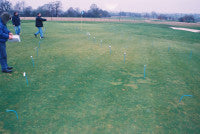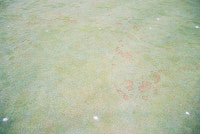Thinking about Pesticides
 When it comes to controlling troublesome weeds, pests and diseases in the sports turfgrass areas you manage, how much do you think about the products you use? Too often managers just buy what their adviser recommends, place the delivered product in store and wait for a licensed spray operator to apply it when conditions are suitable.
When it comes to controlling troublesome weeds, pests and diseases in the sports turfgrass areas you manage, how much do you think about the products you use? Too often managers just buy what their adviser recommends, place the delivered product in store and wait for a licensed spray operator to apply it when conditions are suitable.
In fact it is worth taking the time to understand what is in the product and how it has been developed. It is essential to know about its registration and you really should know whether it is right for your needs.
Protecting sports turfgrass
Over the years pesticides - or more correctly plant protection products - have made significant contributions towards establishing and maintaining safe, high quality sports turfgrass. They have helped to effectively manage populations of insect pests and disease causing organisms as well as weeds. The result is improvements in both the appearance and playing qualities of turf swards. Plant protection products are an important component of the greenkeeper's and groundsman's 'tool box'.
Product contents
Plant protection products are specifically formulated to achieve control of specific weeds, pests or diseases. Each product contains one or more substances (active ingredients) that are active against the target. Highly trained formulation scientists combine these with other substances to achieve desirable characteristics in the finished product e.g., effectiveness, ease of use, reduced packaging and no hazard classification.
How active substances are brought to the market
1. Discovery phase
Identifying a potential active substance is the first step. Each year, research based companies screen many thousands of potential candidates for useful activity. Some candidates may have been synthesised in the laboratory, others may come from natural sources. As well as assessing pest activity, early stage tests will also assess safety for users and the wider environment. On average just one out of 70,000 candidates will emerge from the screening process and go to the development phase.
2. Development phase
Selection continues in the development phase with many more candidates failing to meet the rigid selection criteria of activity and safety in more extensive tests. The few that do emerge are then incorporated into a range of formulations that are tested further in strictly controlled early field trials. Again the criteria are effectiveness and safety, but under a range of different environmental conditions.
These trials continue for several years to investigate activity against target pests, weeds and diseases and to achieve the best results using difficult application methods. The tests will provide experience of the product's performance in different seasons and in weather conditions. Plant protection products for sports and turfgrass will be subject to specific trials on suitable areas that reflect commercial use.
Alongside the turfgrass testing, extensive toxicological and environmental studies are completed along with assessments of any breakdown products. Safety and stability of the formulated product in the final pack is needed.
3. Registration
Before a plant protection product can be sold in a particular country it must be approved by the relevant national regulatory agency. All the data generated over the years of trials and studies are submitted for evaluation by the agency which decides whether or not to grant the approval.
Time and costs
From the first time an active substance is discovered to the first sale takes on average 9.1 years and only one out of 139,000 candidates screened will make it to the market. And the average cost is £140 million (Source: Pesticides in Perspective, published by Crop Protection Association, May 2007).
Conclusion
Plant protection products represent a massive investment in development and registration. The process is highly complex and represent a high economic risk to the research company. The products are highly tested and regulated. Even after registration independent scrutiny will continue to assess any risks once the product is in practical use.
To ensure they are continue to be available for tomorrow's turfgrass manager those using them today need to ensure they act responsibly. This includes correct and legal product selection, measuring accurately the area to be treated, applying the right amount of product at the right time and checking application equipment before use and that it is correctly calibrated.
Dr Mike Drinkall
Technical Specialist
Dow AgroSciences
